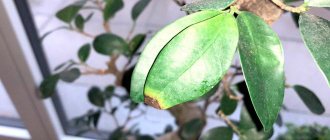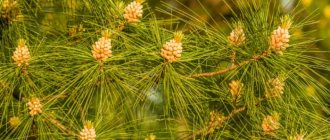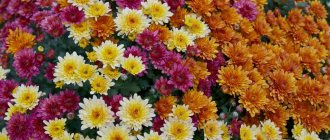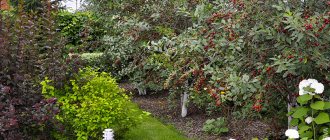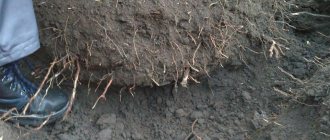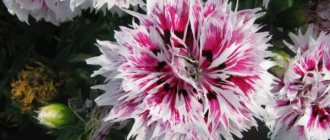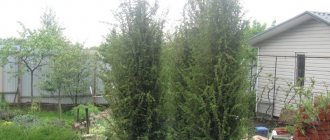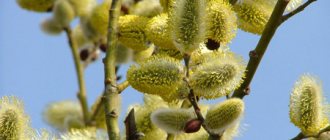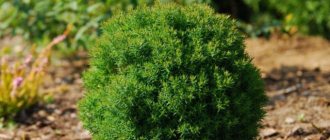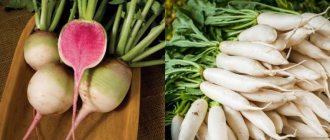Author: Natalya Category: Garden plants Published: February 25, 2019Republished: February 25, 2019Last edits: November 03, 2020
- Growing conditions
- Reproduction methods
- Autumn work
- Balsam fir (Abies balsamea)
plant (lat. Abies) represents a genus of the Pine family. The Russian name of the plant comes from the German word Fichte, which means “spruce”. Spruce-fir is widespread in subtropical, temperate and even tropical regions of the Northern Hemisphere, including El Salvador, Mexico, Honduras and Guatemala. Most often, fir lives in coniferous forests, in proximity to trees such as cedar, spruce and pine, but it is also found in mixed and even deciduous forests. The genus has about 50 varieties - from shrubs 50 cm high to trees 80 m high. Currently, decorative fir is incredibly in demand in landscaping both personal plots and public parks and squares. She is beautiful and unpretentious. Disadvantages include low frost resistance, as well as fir intolerance to smoke, gas and too dry air.
Planting and caring for fir
- Planting: planting four-year-old seedlings in the ground - at the end of August or at the beginning of September, but it is also possible in April.
- Flowering: grown as an ornamental foliage plant.
- Lighting: shade or partial shade, preferably near a pond.
- Soil: Moist, well-drained, rich, preferably loamy.
- Mulching: in the spring with a layer of peat, wood chips or sawdust 5-6 cm thick.
- Watering: moisture-loving species are watered 2-3 times per season during the dry period, spending 15-20 liters of water on each plant. Other types of fir do not require artificial watering.
- Top dressing: with mineral complexes, in the spring, from the third or fourth year after planting in the ground.
- Pruning: mainly for sanitary purposes in early spring, before sap begins to flow.
- Reproduction: species firs can be propagated by seeds, but cultivars can only be propagated by cuttings, since the seed method does not preserve the varietal characteristics of the parent plant.
- Pests: spruce-fir hermes (a type of aphid), spider mites, click beetles, fir longhorned beetles, beetles.
- Diseases: rust, root rot.
Read more about growing fir below.
Botanical description
Fir is a monoecious plant, evergreen, heat-loving and shade-tolerant. Its root system is powerful, pivotal, and goes deep into the ground. Fir bark in young years is thin and smooth, but with age it becomes thick and cracked. The crown is cone-shaped, starting right at the base of the trunk - this is what distinguishes fir from other coniferous trees. Fir branches are arranged ring-shaped and horizontal, fir leaves are flat, entire-edged soft needles, narrowed at the base into a short petiole.
Fir needles do not acquire a dirty red hue in winter, as happens with many other conifers; each fir needle is decorated with two white stripes on the bottom. On reproductive branches the needles are pointed, on vegetative shoots they have a slightly notched or rounded tip. Male flowers look like earrings of cones, and female flowers are ovoid, cylindrical or ovoid-cylindrical, with cones sticking up (another difference between fir and other conifers, whose cones usually hang). Female fir cones consist of a rod on which cover scales sit, inside which there are fruit scales bearing two ovules. Fir trees are pollinated by the wind.
When fir seeds ripen, the scales on the cones become woody and fall off, releasing the winged seeds and leaving only the stems on the tree. In cultivation in one place, fir can live up to three hundred years.
- Stratification at home
Combination with other plants
Fir goes well with other plants. She landscaping the area both in winter and summer. If you want the garden at your dacha or suburban area to always look well-groomed, be sure to plant a fir tree.
Since ancient times, Chinese and Japanese culture began to grow dwarf trees such as bonsai. An ordinary tree is placed in such conditions that it can grow, but cannot reach a large size. Therefore, it always remains miniature. This composition can be grown right at home.
To make fir look organic, you need to learn how to combine it correctly with other plants. To do this, you need to know which trees will look good next to it:
- If you plant a tall fir as a green garden, you can combine it with other coniferous trees. Spruce, thuja pine, larch and other similar plants will look good next to it. A garden like this will look great both in winter and summer.
- It also goes well with other trees. This could be an apple tree, cypress, barberry, birch and so on. In this case, only the fir will remain green in winter, but this will not spoil the look of the beautiful snow-covered garden.
- Dwarf species can be planted in flower beds. They look great surrounded by stones; such an environment will be enough to create an incredible composition.
- Miniature fir looks no less charming in combination with flowers. Low roses, red, purple and yellow dried flowers, as well as other low-growing plants, look beautiful.
- This plant looks good together with other low-growing greens. For example, it goes well with thyme and moss.
Thus, fir really is a real decoration of any garden. It looks great in combination with other plants and can grow both in the southern countries of our country and in the Moscow region.
Fir planting
When to plant
To plant in the ground, you will need fir seedlings at least four years old. They need to be planted in April, or even better in late August or early September, and it is advisable to choose a rainy or cloudy day for planting. A place for fir is chosen in the shade or partial shade in areas with moist, rich, well-drained soil, ideally it should be loam. It’s great if there is a body of water not far from the place where the fir will grow.
How to plant
Two weeks before planting the fir, dig a hole approximately 60x60x60 in size, although the dimensions of the hole depend on the volume of the root system of the seedling. Pour 2-3 buckets of water into the hole, and when it is absorbed, dig up the bottom with half a shovel and place a layer of crushed stone or broken brick 5-6 cm thick in the hole. Then fill the hole halfway with thoroughly mixed soil of the following composition: 3 parts humus, 2 parts of clay, 1 part of peat and sand, 10 kg of sawdust and 200-300 g of nitrophoska.
After two weeks, when the soil in the hole has settled, lower the roots of the seedling into it so that the root collar is flush with the surface of the site - it is most convenient to install the seedling on a mound of soil mixture. Straighten the roots of the seedling, fill the hole to the top with nutritious soil of the composition described above and compact it thoroughly. After planting, water the fir. If you decide to grow a fir alley, place the seedlings at a distance of 4-5 m from each other. Group planting of fir trees requires a distance between seedlings of 3-3.5 m for loose groups and 2.5 m for dense groups.
Plant characteristics
Like every plant, fir has a number of special characteristics, which may differ to some extent depending on the variety of the plant.
The main parameters of fir can be divided into the following categories:
- height;
- growth rate;
- endurance;
- demandingness.
Speaking about the size of this plant, it should be understood that the culture can be of two types:
- medium height (150–200 years);
- tall (300 years or more).
The average height of the tree in question is 0.5–90 m, depending on external factors.
Did you know? Fir seeds are distinguished by their lightness
-
1000 copies will weigh no more than 6-7 g.
Fir usually grows up to 150-300 years, but there are cases when the plant lived for more than 6 centuries . The Pine genus under consideration is characterized by slow growth; a young tree grows by 11–15 cm per year. The growth rate increases by 7–10 years of the plant’s life.
Fir is considered a shade-tolerant crop, so it is good to plant it both in partial shade and in shaded areas . Most varieties of this coniferous plant are characterized by high winter hardiness and can withstand temperatures from –15 to –25°C. Young trees are not frost-resistant enough, so before wintering they must be covered with special garden fabric or spruce branches. An adult plant is significantly resistant to frost.
Fir is considered a “fog tree” because it loves moisture, but wetlands or waterlogging of the soil negatively affects the root system, which can lead to the death of the plant
Although this genus of Pines is considered heat-loving, it does not tolerate heat and drought; there are frequent cases of needle burns from prolonged exposure to the sun. It is recommended to plant the tree in areas protected from winds.
Fir care in the garden
Growing conditions
When caring for seedlings, loosen the soil to a depth of 10-12 cm after watering and remove weeds. It is advisable to mulch the trunk circle of young plants with a diameter of 50 cm with wood chips, sawdust or peat, a layer of mulch - 5-8 cm, just make sure that the mulch does not lie close to the root collar of the fir. It will be necessary to feed the fir after planting only after 2-3 years, adding 100-125 g of Kemira-universal to the tree trunk in the spring. You will only need to water the fir if you are growing a moisture-loving species, for example, balsam fir, which requires watering 2-3 times a season during dry times.
The amount of water per watering is 15-20 liters. Other species do not need artificial watering - firs do not like waterlogging; natural precipitation is enough for them.
As for pruning, in the spring, before the sap begins to flow, dry and damaged branches are removed, and the fir crown is formed, if necessary. Pruning is done with garden shears. During one haircut, shoots are shortened by no more than a third of their length. In general, fir has a natural, neat crown that does not require shaping.
Transfer
Compared to other plants, coniferous trees adapt quite easily after transplantation. If you decide to transplant a young plant, use a sharp shovel to pierce the soil in a circle at a distance of 30-40 cm from the trunk, then use a shovel to pry this marked circle at the depth of the bayonet, take it out along with the roots and a lump of earth, transport it in a wheelbarrow to a new hole and carefully move into her. An older tree needs to be prepared for replanting: the soil should be pierced in a circle a year before replanting, and the diameter of the circle in this case should be larger.
Over the course of a year, the fir will grow new young roots inside the designated circle and, thanks to this, will more easily withstand the test of replanting. It will be difficult for one person to just remove the fir from the ground, transport it and plant it in a new place, so look for an assistant. The main thing in this process is to prevent the earthen lump from falling apart.
Pests and diseases
As you can see, planting and caring for fir is simple, and the plant will not require any special skills or effort from you. Fir is quite resistant against such troubles as diseases and pests, however, there are cases when fir loses its decorative effect due to spruce-fir Hermes - a type of aphid, from whose vital activity the fir turns yellow.
To combat Hermes, use the preparations Rogor or Antio: in early spring, when overwintered female aphids wake up, treat the fir with a solution of one of these preparations at the rate of 20 g per 10 liters of water. These insecticides will also save your tree from other harmful insects - fir shoot moth and fir pinecone leaf roller.
Sometimes the needles of a beautiful fir begin to turn yellow, and rusty cushions form on the shoots, and the reason for this is the fungal disease rust. The affected branches are cut off and burned along with fallen pine needles, the sections are treated with garden varnish, and the crown is sprayed with a two percent solution of Bordeaux mixture. And carefully inspect the area: plants such as chickweed or chickweed should not be there where conifers grow.
Results about growing fir
Korean fir is a beautiful tree. This is a good solution for country houses or private properties. Does not like darkness, polluted air. But it tolerates frost well, and the crown does not need to be trimmed. Therefore, caring for her will not be difficult. The plant has two types - a dwarf version and a regular coniferous tree.
Currently reading:
- How to grow Chinese cabbage in open ground
- Planting to decorate the site with three types of coniferous trees
- Using hydrogel in open ground for plants
- Restoration and stimulation of orchid flowering with succinic acid
Share the news on social networks
About the author: Lyudmila Vasilievna Nosikova
Agronomist of the state agricultural enterprise "Garovskoe" of the Khabarovsk region of the Khabarovsk Territory.
Fir propagation
Reproduction methods
Species fir is propagated by seeds, which are harvested at the very beginning of the ripening of cones, and decorative varieties are taken from cuttings.
Propagation by cuttings
Cuttings for rooting 5-8 cm long should be taken only from young trees, and these should be annual shoots with one (not two - this is important) apical bud and always with a heel. If you want to get a cutting with a heel, then it is better not to cut it, but to tear it off with a sharp movement along with fragments of the bark and wood of a more mature shoot. Cuttings should be harvested in the spring, before sap flow begins, on a cloudy morning from the middle part of the crown on its northern side. Before planting, carefully remove burrs from the heel.
- Corydalis: growing and care in the garden
Make sure that the bark on the heel does not peel off from the wood. To avoid the further development of fungal diseases, the cuttings are kept for 6 hours in a two percent solution of Fundazol, captan or a dark pink solution of potassium permanganate. Then the cuttings are planted in a mixture of sand, humus and leaf soil in equal parts and covered with a transparent cap. In order for the cuttings to take root faster, it is advisable to arrange the bottom heating of the substrate 2-3ºC above room temperature. The cuttings should be kept in a bright, but not sunny place, with daily ventilation.
For the winter, the container with cuttings can be moved to the basement, and in the spring it can be taken out into the fresh air. It will take a long time for the cuttings to take root - the fir will first grow callus, and only in the second year will roots appear.
Growing from seeds
Collecting fir seeds is not easy, since the cones of mature trees ripen high, and as soon as they ripen, the winged seeds from them immediately scatter. But if you are lucky enough to get a slightly unripe cone, dry it, remove the seeds and store them in the refrigerator or in the basement with high humidity until sowing - fir seeds need stratification before planting. In April, the seeds are sown in a bed to a depth of 2 cm in soil made of sand and turf and covered with film without watering to avoid the formation of a crust on the surface of the soil and to speed up the emergence of seedlings.
When the sprouts sprout after 3-4 weeks, start watering, loosening and weeding the beds. In the first winter, the seedlings are covered with spruce branches. Next year you can plant the seedling in a permanent place. Fir from seeds initially grows very slowly: in four years it reaches a height of 30-40 cm, since it mainly develops the root system. But then growth accelerates noticeably.
How does fir grow?
Unlike most coniferous crops, fir is demanding in terms of growing conditions. Most species are quite thermophilic, and some do not tolerate frost at all. Only firs growing in the taiga zone are relatively resistant to low temperatures, but they cannot be compared with other conifers in this regard.
The crop is demanding on soil fertility, needs protection from strong winds, but is extremely shade-tolerant. It does not tolerate drought or waterlogging. The species tree will not grow in megacities or where there is any air or groundwater pollution. The varieties are more hardy.
Fir in winter
Autumn work
The firs recommended for planting in the middle zone tolerate our winters well, but young plants must be covered with spruce branches and the trunk circle mulched with peat or dry leaves with a layer of 10-12 cm.
Wintering fir in the country
Adult plants overwinter without shelter, but at the end of winter you need to cover the fir trees with non-woven material to protect them from the spring sun - they can be seriously damaged by its rays, which are too bright at this time.
Interesting facts about fir
The bark of the culture is used to make balsam, and the needles and young branches are used to make fir oil.
Freshly cut branches contain so many phytoncides that they can destroy microbes in the room.
The aroma of fir is strong, but not at all similar to spruce.
The branches make excellent bath brooms.
In times of famine, they crushed the bark and baked bread - it was not very tasty or nutritious, but it allowed them to survive.
Fir is easily propagated by layering. Often the branches simply lie on the ground and take root.
The culture grows in Siberia, the Far East and the Urals, but is rarely found in central Russia.
There is practically no undergrowth in fir forests, since the branches of the main species begin to grow very low.
The Trojan Horse was made from Cephalinian Fir.
It is believed that the branches of this tree protect against witchcraft and help the dead in the other world.
Types and varieties
Among the large number of species and varieties of fir, there are plants that are more and less in demand in culture. We offer you an introduction to the most popular of them.
Balsam fir (Abies balsamea)
It grows in nature in Canada and the USA, its habitat in the north is limited to the tundra, and in mountainous areas it can be found at an altitude of 1500 to 2000 m. It is a shade-tolerant, frost-resistant fir, which, unfortunately, is not distinguished by longevity - it lives no more than 200 years. Balsam fir is a tree with a height of 15 to 25 m with a trunk thickness of 50-70 cm. The bark on young trees is smooth, ash-gray in color; on older trees, the bark is reddish-brown, fissured. The buds are resinous, greenish with a pale lilac tint, ovoid or spherical.
The needles, 15 to 30 mm long, shiny, dark green with stomatal lines along the entire leaf, blunt or slightly notched at the top, do not fall off for 4-7 years; when rubbed, they emit a pleasant smell. The cones are oval-cylindrical, 5-10 cm in height, 2-2.5 cm in width, unripe have a dark purple hue, when ripe they become brown, very resinous.
This species has been in culture since 1697. Balsam fir is used in single and small group plantings. Known forms:
- Hudsonia is a dwarf mountain fir with a wide crown, very dense branches and short numerous shoots. The needles are also short, wide and flat, black-green on the upper side and greenish-blue on the lower side. In culture since 1810;
- Nana - fir height is no more than 50 cm, the crown is rounded, up to 2.5 m in diameter, the branches are spreading, horizontal, dense, the needles are short, thick, very dark green, yellow-green on the underside with two white-blue stripes. In culture since 1850. Used for landscaping terraces, roofs, rocky gardens.
Other forms of balsam fir grown in cultivation include gray, silver, variegated, columnar, prostrate and dwarf.
Korean fir (Abies koreana)
It grows in the mountains of the south of the Korean Peninsula at an altitude of 1800 m, forming pure and mixed forests. At a young age it grows very slowly, but with age it accelerates. The height of the Korean fir is about 15 m, the trunk is from 50 to 80 cm in diameter, the crown is cone-shaped, the bark of young trees is smooth, ashen, sometimes with a purple tint, while that of old trees is chestnut with deep cracks. The buds are slightly resinous, almost round, the needles are thick, hard, the needles are saber-shaped, with a notch at the top, dark green on the upper side, silvery on the lower side due to two wide stomatal stripes.
The cones are cylindrical, 5-7 cm long, up to 3 cm in diameter, purple-lilac when young. Fir was brought to Europe in 1905. In decorative terms, this beautiful and winter-hardy species with two-color needles has no equal.
It was the planting of Korean fir that was described in this article, just as the care of Korean fir was the basis for the subsection on caring for plants of the fir genus. Varieties of Korean fir:
- Spruce: planting and care, reproduction and types
- Blue Standard - very similar in characteristics to the original species, only its cones are dark purple;
- Brevifolia is a slow-growing cultivar with a rounded dense crown, but with looser needles than the original species, swamp-green above and whitish-gray below. The cones are purple, small;
- Piccolo - height is only 30 cm, the crown is spreading, horizontal, with a diameter of up to one and a half meters in an adult plant. Needles, like the original species.
Caucasian fir, or Nordmann fir (Abies nordmanniana)
It is a Caucasian endemic, as it grows naturally only in the Caucasus Mountains. This is a tree up to 60 m high and a trunk up to 2 m thick, with a dense, branched, low-slung crown of a narrow conical shape with a sharp apex, which is not so pronounced in adulthood. The bark is smooth and shiny, but from the age of eighty deep cracks begin to appear on it. The buds are ovoid, almost without resin. The needles are up to 40 mm long, up to 2.5 mm wide, dark green on the upper side, with two white stripes on the lower side, on vegetative shoots the tips are notched, on cone-bearing shoots they are softly pointed. The cones, up to 20 cm long and up to 5 cm in diameter, are green when young and dark brown, resinous when mature.
This fast-growing species lives up to 500 years. The following forms of Caucasian fir are known: erect, weeping, golden, golden-tipped, white-tipped and gray.
Single color fir (Abies concolor)
This is the queen of firs native to northern Mexico and the southwestern United States, where it can be found in river canyons and on mountain slopes at an altitude of 2000 to 3000 m above sea level. This is one of the most drought-resistant species, with a lifespan of three and a half centuries. The height of single-color fir is from 40 to 60 m, the thickness of the trunk is up to 2 m, the crown is cone-shaped, quite dense in youth, and becomes much thinner in old age. The old bark is ash-gray, rough, and full of cracks. Spherical, resinous yellow-green buds reach a diameter of 5 cm. Bluish-green needles up to 7 cm long, up to 3 mm wide, with a notched rounded tip, have stomatal lines on both the upper and lower sides. The cones are oval-cylindrical, up to 14 cm long and up to 5 cm wide, purple or green when immature, light brown when mature.
In culture since 1831. Fir looks most impressive in autumn against the background of yellowing larches. The most famous decorative forms:
- Compacta fir is a dwarf-sized shrub cultivar with outstretched branches and blue needles. It is sometimes called Compacta Glauca;
- Violacea is a fast-growing tree up to 8 m high with a wide cone-shaped crown and long blue-white needles. It is highly decorative and drought-resistant.
Siberian fir (Abies sibirica)
It grows in the northeast of the Russian Federation in the highlands and river valleys. This shade-tolerant, winter-hardy species is protected by the state. Siberian fir is the most famous representative of the genus. This is a tree up to 30 m high with a narrow cone-shaped crown. The gray bark, smooth along almost the entire length of the trunk, cracks in the lower part. The needles are narrow, soft, shiny, up to 3 cm long, dark green on top and with two white stripes on the bottom. The cones are erect, light brown when ripe.
Varieties: blue, white, variegated, elegant and others.
In addition to those described by us, in the culture there are subalpine, Fraser, whole-leaved, equal-scaled, Semenova, Sakhalin, myra, graceful, cephalin or Greek, tall, Vicha, white-barked or bud-scaled, white or European and Arizona.
What does a fir tree look like?
Abies or Fir belongs to gymnosperms from the Pine family (Pinaceae). The genus includes, according to various sources, from 48 to 55 species, often very similar to each other to such an extent that only a specialist can distinguish them.
Comment! Douglas fir actually belongs to the genus Pseudotsuga.
From a distance, the plant can be mistaken for spruce, but in fact, fir in the Pine family is closest to cedar. Even an ordinary fan of conifers will definitely pay attention to the cones growing upward, which is typical for the genera Abies and Cedrus.
Young trees form a regular conical or spire-shaped crown. With age, it becomes somewhat deformed, becoming wider, flattened or rounded. All types of fir trees are quite homogeneous and similar to each other, they have one straight trunk that can bend slightly only at high altitudes.
The branching is very dense. The shoots grow strictly in a spiral, making one revolution per year. This way you can even determine the exact age of a fir without cutting down the tree to count the rings. The branches are located in a horizontal plane, close to the ground, in contact with which they are able to take root. Then a new tree grows next to the old fir.
On young trunks and branches, the bark is smooth, thin, and penetrated with resin passages that form nodules. From the outside they can be detected by noticeable bulges. In old trees, the bark cracks and becomes thick.
The tap root goes deep into the ground.
How tall is the fir
The height of an adult fir tree ranges from 10 to 80 m, and depends not only on the species. Plants will never reach maximum size:
- in culture;
- in case of poor environmental conditions in the region;
- high in the mountains.
It is noteworthy that for the first 10 years the crop grows very slowly, then the pace increases noticeably. The tree increases in size until the end of its life.
The diameter of the crown of a fir growing alone in an open place is usually (but not always) more than 1/3, but less than 1/2 of the height. But in nature, the crop often forms dense, dark forests where trees are located close to each other. There the crown will be much narrower.
The trunk diameter can range from 0.5 to 4 m.
Comment! The given characteristics of fir refer to species trees; varieties obtained from mutations or by selection can vary greatly in height and crown proportions.
Location and length of fir needles
When identifying species, one of the distinguishing features is the size and location of fir needles. What is common to all is that the needles are single, flat, arranged in a spiral, with two white stripes on the underside. They are dark green and glossy on top.
The tips of the needles can be blunt or jagged, and the shape is lanceolate. The needles reach a length of 15 to 35 mm with a width of 1-1.5 mm, rarely up to 3 mm. When rubbed, they emit a pleasant aroma.
The needles last on a tree for 5 years or more (on average from 5 to 15 seasons), the longest for the Sweet Fir (Abies amabilis). According to the American Gymnosperm Database, this species does not lose its needles until it is 53 years old.
By and large, the fastening of needles on a tree can be divided into three large types, although, in fact, they are still located in a spiral.
Important! This is not a scientific classification, it is very arbitrary, taking into account not biological features, but exclusively the visual effect.
In addition, the location of the needles on the shoots depends on many factors, namely:
- type of fir;
- needle age;
- degree of illumination of shoots.
But amateur gardeners need to know what needles may look like, because in regions where this crop is rarely grown, they have doubts about the ancestry of the tree. Owners of private plots often complain: “I bought a fir tree, but it’s unclear what grew, its needles should be positioned differently.” So:
- The needles point upward, like the bristles of a toothbrush.
- The needles are attached in a circle (actually in a spiral), like a brush.
- The needles are located symmetrically on the branch, like on a double-sided comb. Most often, such needles are formed on the side shoots.
Different needles can grow on one tree. Located inside the crown or on lower, light-deprived branches, the needles will in any case differ from the apical, well-lit ones, and young ones will differ from mature ones. When identifying species, they always focus on adult needles.
When the needles fall, they leave a clearly visible mark on the shoot, similar to a convex disk.
How fir blooms
Fir begins to bear fruit in dark forests at 60 or 70 years of age. Single trees growing in an open sunny place bloom twice as early.
Male pollen cones are solitary, but grow in large dense groups on last year's shoots and open in the spring. After release, the pollen quickly falls off, leaving yellowish convex marks on the branches.
Female flowers are reddish-violet or green, solitary, located only on the upper part of the crown. They are directed upward, growing on branches that appeared last season.
Comment! All trees of the genus Abies are monoecious.
What do fir cones look like?
Fir is a coniferous tree with cones located strictly vertically. They ripen in one season and look very decorative.
Photo of fir with cones
The size, shape and density of fir cones depend on the species. They can be resinous or not very resinous, from ovoid-oblong to cylindrical or fusiform. The length of the cones varies between 5-20 cm; young ones can be purple, greenish, reddish, but by the end of the season they turn brown.
As the winged seeds mature, the scales become woody and fall off. Only the axis of the cone remains on the tree, looking like a giant thorn. This is best seen in the photo.
Comment! The size and shape of the cones, as well as the location of the needles, make it possible to determine what species the fir belongs to.
Properties of fir
Fir is a special plant even among conifers. Its wood does not contain resinous substances, so musical instruments are made from it and ships are built. Fir bark is a raw material for valuable balsam, and needles and branches are used for fir oil. A decoction is prepared from the needles and bark, which reduces the acidity of the stomach, increases efficiency and immunity, and relieves toothache.
Fir resin is a good antiseptic used in folk medicine to lubricate wounds, cuts, abrasions and ulcers. Early settlers to America and its indigenous inhabitants widely used fir resin, which has a pleasant taste, for medicinal purposes: it was used to treat bronchitis, cough, sore throat and even tuberculosis, as well as cancer, dysentery, otitis, inflammation of the mucous membranes, and some urogenital diseases (for example , gonorrhea and vaginal infections), scurvy, rheumatism, muscle and joint pain.
Medicines containing an extract based on fir cell sap are used in the treatment of rheumatism, inflammatory processes, infectious diseases, chronic and acute heart failure. Consumption of fir cell sap:
- stimulates hematopoiesis;
- strengthens the immune system, restores the body's protective function;
- has an anti-inflammatory effect in the treatment of pulmonary diseases;
- serves as a prevention of cancer and cardiovascular diseases;
- prevents the development of hypertension;
- improves the functioning of the excretory organs;
- normalizes the functioning of the stomach and intestines;
- replenishes the lack of vitamins, micro- and macroelements in the body;
- protects against the effects of radiation;
- relieves stress, has an antioxidant effect and increases the body's resistance to adverse environmental factors.
Fir juice comes on sale in the form of phyto-cocktails, which are ready for use, and in its natural form - this liquid can only be consumed internally in a diluted form.
Fir essential oil helps even in cases in which various chemotherapy drugs are powerless, for example, it slows down and even stops the growth of cancer cells. The oil enters the blood immediately and is collected at the site of the disease, bypassing the digestive organs, and therefore without decomposing. Its combat component is camphor.
Fir oil is a universal medicine that has bactericidal, antiseptic, analgesic, anti-inflammatory, restorative, soothing and tonic effects. It is widely used not only in medicine, but also in cosmetology to treat acne, lichen, furunculosis, relieve swelling, smooth out wrinkles, eliminate sagging skin, warts and other skin problems.
The use of fir and medicines made from it requires compliance with certain rules: during treatment it is necessary to refrain from drinking alcoholic beverages, even weak ones, since alcohol neutralizes the effect of the drugs. Stop taking fir medications if you find that your body is intolerant to them. Patients with epilepsy, gastritis or gastric ulcers and those with kidney pathology should not be treated with fir. This is contraindicated for pregnant and lactating women, as well as children.
Improper use of drugs or violation of dosage can cause an allergic reaction. If you experience itching, swelling and red spots on the skin, it is better to stop taking the drug. If you don’t know how the body will react to fir, do a test: drop 10-15 drops of oil or juice on the back of your hand or leg and rub thoroughly into the skin. If the allergy does not appear within the next two to three days, you can take the drug, but be sure to consult your doctor about the dosage.
